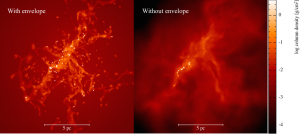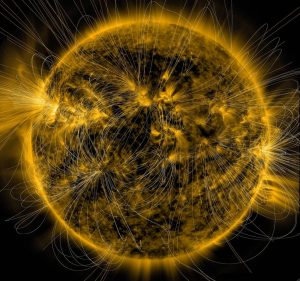Star formation
- Clouds & clusters – Ian Bonnell, Claudia Cyganowski, Aleks Scholz, Kenny Wood
- Discs & planet formation – Aleks Scholz, Kenny Wood
- Stellar magnetospheres & winds – Moira Jardine
- Brown dwarfs & planetary-mass objects – Aleks Scholz
- Massive stars – Ian Bonnell, Claudia Cyganowski
Clouds & clusters
Ian Bonnell, Claudia Cyganowski, Aleks Scholz, Kenny Wood
Galaxies such as our own are constantly forming new stars, primarily in dense clouds of gas and dust that turn into stellar clusters. Gravity, acting to collapse the material in the clouds, is variously helped and hindered by turbulence, pressure, magnetism, and potentially feedback from previously-formed stars. The interplay of forces makes it a complex process and it is still not certain how they determine the final properties of the resulting stars and stellar clusters. In an effort to understand this, the St Andrews research group combines observations of star forming regions with hydrodynamical and radiative transfer simulations of the process. Thus we can examine the process at the largest scales of entire galaxies in order to understand how star forming clouds are themselves formed, and at the smallest scales where we can follow the formation of individual stars.

Discs & planet formation
Aleks Scholz, Kenny Wood
Planets form in disc-shaped nebula surrounding young stars. Over timescales of several million years, these protoplanetary discs are shaped and later consumed by accretion onto the star, winds, the high-energy radiation by the Sun – and the formation of gaseous and rocky planets. The formation of planets like Earth is a bottom-up process, starting with the growth of dust grains to pebbles and subsequently to rocky cores. Giant planets on the other hand may also form through large-scale fragmentation and collapse in the outer disc. Understanding the initial conditions and early stages of planet formation requires observations across the electromagnetic spectrum, combined with hydrodynamic, chemical and radiative transfer modeling. The dust and gas in the discs emit radiation at infrared and radio wavelengths, but also affects the visual light observed from young stars through obscurations and accretion bursts. We analyse multi-wavelength and time-domain observations of young stars, using a combination of ground-based and space telescopes, including the new submm/mm interferometer ALMA and the infrared space observatories Spitzer, Herschel and (in the future) JWST.
Stellar magnetospheres & winds
Moira Jardine

In its youth, our Sun probably had a magnetic field that was more active than it is today, resulting in larger flares, a hotter corona and more powerful radio and X-ray emission. This field would have had a significant impact on planet formation and on the way the Sun has been spun down from its initial phase of rapid rotation. We are modelling the generation of magnetic fields deep within young stars and the way these fields are structured in the outer stellar corona. From Zeeman-Doppler images of the surface magnetic fields of young Suns we can extrapolate the coronal field to show the open field lines (where a wind might escape) and the closed field lines where stellar prominences may form (see figure). By studying the structure of these fields for a range of stars as they spin down with age, we hope to learn more about the early stages of stellar evolution.
Brown dwarfs & planetary-mass objects

Aleks Scholz
Brown dwarfs are substellar objects with masses below 0.08 times the mass of the Sun, including free-floating objects with masses comparable to those of giant planets. Brown dwarfs are found in all star forming regions, open clusters and in the solar neighbourhood, but how they form is an open question. To explain their large numbers, additional physics has to be incorportated in our models for star and planet formation like turbulence, photoerosion, or dynamical ejections from disks or multiple stellar systems. We carry out very deep surveys of star forming regions to identify young brown dwarfs, measure rotation periods, examine their kinematics and discs. Apart from constraining the scenarios for the origin of brown dwarfs, we are interested in finding out if and how brown dwarfs can form their own miniature planetary systems. Young brown dwarfs have warm, low-gravity atmospheres that are comparable to those of young planets, but in contrast to exoplanets they are not outshined by host stars, and much easier to observe. This makes young brown dwarfs excellent test cases to develop models for planetary atmospheres.
Massive stars
Ian Bonnell, Claudia Cyganowski
On the other end of the mass spectrum are stars with masses of ten to hundred times the mass of the Sun. They strongly affect the star forming environment through radiative feedback, winds, and gravity. After their short lifespans, the resulting supernova explosions spawn new episodes of star formation. Again the interplay between observations and simulations is key for understanding these processes. Our observations of massive star formation are primarily based on high-resolution, long-wavelength data, acquired using facilities like VLA, SMA or ALMA.
